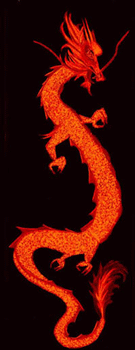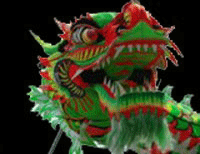- Home
- Martial Art History
- Chinese Martial Arts
History of Martial Arts: Chinese

One version of how Chinese Martial Arts started was by a Bad-Ass Indian monk who brought Martial Art techniques along with internal strength or Chi from India to China and the Shaolin Temple.
His name was TA MO, or called Bodhiharma in India. Bodhiharma was born a prince in a small tribe from Southern India. And since he was a prince, he was a member of the warrior class and was trained in Martial Arts techniques.
When he was young he converted to Buddhism and was trained in Martial Arts, along with meditation. He trained for many years and before his master died, Bodhiharma was asked by him to spread Buddhism to China.
He didn't know it at the time but he would be a major influence in the development of Chinese Martial Arts. Bodhiharma traveled to China in 526 A.D. After he arrived he was invited to meet with the Emperor.
But apparently Bodhiharma wasn't shy and spoke his mind and his teaching offended the Emporer and he was asked to leave.
The Shaolin Temple
During his time with the Emperor he had heard of the Shaolin Temple, and decided to go there. At this time Chinese Martial Arts techniques were not practiced there; it was only a temple for meditation. Bodhiharma traveled to the Shaolin Temple to train and lecture the monks there.
When he got there he wanted to find out what kind of monks were there, so he put them through a strenuous routine, and a lot of them couldn't handle it. And to say that Bodhiharma was disapointed is an understatement. He couldn't believe how weak these monks were and proceeded to offend them also. He called them weak, sick, and lazy.
Bodhiharma was a Martial Arts Master with his bare hands, and also with a staff, and so he believed in the need for physical exercise to reach enlightenment. But the Shaolin monks were not happy to be talked to like this, and again he was asked to leave.
Teaching the Monks
So he left, but only went a short distance to a nearby cave and made his home there. He knew that Martial Arts practice could strengthen the monks, but first they had to show him that they were sincere.
So Bodhiharma sat in the cave and meditated for nine years.
Finally a monk came up to the cave with a sword and cut off his own hand to show he was sincere.
And that got Bodhiharma to come out of his cave to teach the 49 I Chin Ching, or Muscle Tendon Changes to the monks. This was based on the idea of dynamic tension. And he also taught the Marrow Washing, and the 18 Hand Movements. Later named the 18 Lohan Shou, or Enlightened Hands.
These were the first Chinese Martial Art techniques practiced at the Shaolin Temple, and this began the Art of Shaolin.
The Indian Martial Art that Bodhiharma taught the monks may have been Varmakkalai. One reason is that Varmakkalai and the Shaolin Temple agree that there are 108 varma points, or life centers in the body.
This art went through many changes and came to be known as Shaolin Boxing, or Kung Fu. These Chinese Martial Art techniques were refined and added to six other Temples. It was after these teachings, that the Chinese Martial Arts became famous and the Shaolin Temple monks became known for their Fighting Skills.
There became hundreds of styles of Kung Fu.

They were divided between Northern styles, and Southern styles.
And Internal and External.
The northern styles are more kick-oriented, and the southern styles are more hand-oriented. Later Kung Fu went on to influence many other Asian Martial Arts.
After Bodhiharma's death
About 800 years after Bodhiharma's death, an experienced Martial Artist named Chueh Yuan arrived at the Shaolin Temple and devoted his life to further developing Shaolin Kung Fu. Chueh Yuan increased the original 18 hand movements to 72. Yuan then traveled all over China visiting other famous fighting schools and learning from many teachers.
Along the way he met two other famous Chinese Martial Art practitioners named Li Sou, and Pai Yu Feng, and together they returned to Shaolin and added to the Chinese Martial Art techniques of the Temple. They created a new system of Kung Fu, adding to the 72 movements, and increasing them to 172.
The 5 Animal Style
They divided this style into 5 styles, based upon animals, called 5 Animal Style. The animals were the:
- Tiger,
- Leopard,
- Crane,
- Snake, and
- Dragon.
Each animal complimented the other but maintained its own unique characteristics. This style allowed its practioneers to adapt to their own abilities and skill.
The students of 5 Animal Style learned every aspect of the style, and when they were skilled sufficiently in the overall art, then the customization of the style to the practioneer began.
The Tiger...
The Tiger's Martial Arts techniques were perfect for big, strong, powerful Martial Artists who were able to end a fight quickly with simple direct and explosive power.
The Leopard...
Leopards were like small Tigers, aggressive and dominant but not using as much physical force...but with more cunning and strategy. They were intelligent Martial Artists.
The Crane...
The Crane was for the small non-aggressive person who didn't like to attack. This was a defensive style that created opportunities to capitalize on their opponents' mistakes. The practicioners of the Crane needed to be agile, flexible, and accurate.
The Snake...
Snakes used pressure points to disable and control their attackers. Snakes were experts of human anatomy, and could create pain without damage.
The Dragon...
In the Five Animal's form of Chinese Martial Arts, Dragons were those who mastered all and were able to avoid fighting. It was the ultimate in Shaolin principles, but almost unachievable (it was hard to keep from kicking some butt, if the occasion arose when you had been practising Martial Arts techniques your whole life). So there probably weren't too many Dragons at the Shaolin Temple, but nonetheless the Dragon symbol was revered.
The Evolution of Kung-Fu
When the 5 Animals were added to the 18 Lohan, they became known as Chuen Fa, predecessor to Kempo and Atemi Waza.
As time went by there became more and more styles. Today there are thousands of Kung-Fu styles. Other well known Kung-Fu styles are:
- Eagle Claw, a Grappling style that included two old favorites in their inventory, tendon separation, and joint dislocation.
- Hun Gar
- Drunken Boxing
- Choi Li Fut
- Praying Mantis
- Sanshou
Bruce Lee was the most famous modern day Kung-Fu man, he originally trained in Wing Chun, but later became a Mixed Martial Artist.
Bruce Lee was a believer in studying different Martial Arts.
